Yeast Breads Category
Table of Contents
-
Contents of Yeast Breads
Yeast Breads
100% Sprouted Wheat Bread
100% Sprouted Wheat Bread
Sprouted grain is easier to digest and contains more nutrients
than unsprouted grain. Some persons who are wheat sensitive or
allergic to wheat can tolerate it in the sprouted form. This makes
delicious French Bread, Spelt or Kamut may be substituted, increasing
the amount of sprouted spelt flour in step #5 as needed.
AMOUNT: 1 Medium Loaf * 8 1/2 X 4 1/2 " Pan
Bake: 350°F - 50-60 minutes
1. Prepare Sprouted
Wheat.
2. Dissolve yeast with honey in water in a glass measuring
cup; let stand 5-10 minutes until bubbles come up:
1/4 Cup lukewarm water (100-115°F - warm to wrist)
1 tsp. honey
1 TB Saf or active dry yeast
3. Blend together in blender until sprouts are well pulverized:
1 cup hot water (may use water saved from soaking wheat)
2 cups moist sprouted or soaked wheat
4. Blend together in mixing bowl:
pulverized sprouts (Step # 3 above)
2 tsp. salt
1/8 tsp. Vitamin C crystals or 1 tsp. dough enhancer
1
1/2 cups sprouted whole wheat flour
/a proofed yeast mixture (step #2)
5. Add remaining flour until dough in electric bread
kneader clears sides of bowl while kneading or as needed to prevent
sticking whilte hand kneading:
about 1- 1/2 cups sprouted whole wheat flour
6. Knead about 8-10 minutes.
7. Shape dough into loaf, place in greased pan, let rise
until doubled, bake 45-60 minutes or until top, sides, and bottom
of the loaf are browned.
Sprouted Bread Tips: Sprouted bread rises faster than
unsprouted, so watch it closely -- it falls royally, if allowed
too much rise. Since practically no honey is sued in this recipe,
the bread will not be golden brown when it is done.
This recipe is copyrighted from Yeast
Breads by Sue Gregg author of Eating Better Cookbook Series.
Used by permission.
Customers comment:
I talked with you last week regarding this recipe and how to
sprout and dry this much grain...well I did it. I put the grain
on 3 big cookie sheets and covered with a damp cloth and put them
in the oven with the oven light on. It took 24 hours to dry, but
it did just fine, and then I milled the flour and made the recipe.
The bread turned out great!>>>
Download our free ebook called FAST
AND HEALTHY RECIPES FOR BUSY WOMEN -Reliable Recipes for Busy
Families.
For recipes, inspiration, baking tips, and information in the
Spirit of Titus Two join
our bi-monthly newsletter at this link.
Urban Homemaker
2 STAGE PROCESS - For Yeast Breads - Maximizing Nutritional Value
2 STAGE PROCESS FOR YEAST BREADS- Adapting Marilyn's Famous Whole Wheat Bread Recipe to maximize nutritional value
1. Soak the whole grain flour in liquid. Substitute an acid medium such as buttermilk, yogurt, or other cultured milk such as kefir or whey for the water called for in Marilyn's Bread Recipe depending on which version you are making. (Hand, Large Mixer, or Zo method.) Lemon Juice or Vinegar may be added -- 1 TB per cup water as an alternative "acid" ingredient. Use 6 Cups flour for hand method, 14 Cups flour for Large Mixer method. As little as 7 hours soaking time will neutralize a large portion of the phytic acid in grains. 12-to 24 hours is even better with 24 hours yielding the best results.
However, be flexible, soak the flour as long as you have time for so that this process fits into your routine smoothly, any soaking time improves texture, nutrition, and flavor. Just mix the liquid and water long enough to moisten the flour before the soaking time begins. This is a little bit like "sponging" but no yeast is used or any other ingredients. Cover the bowl with plastic wrap to prevent it from drying out or cover the bowl with a damp cloth.
2. After the liquid and flour has soaked overnight or 12 hours, blend in a glass or plastic liquid measuring cup:
1/4 cup-1/2 C. warm water
Saf yeast called for in recipe (Conventional yeasts may be substituted)
1 tsp. honey
If using Saf yeast, the proofing time is not needed, otherwise allow this yeast mixture to stand 5-10 minutes to proof the yeast.
3. Thoroughly whisk together the oil, honey, and salt ingredients called for in your recipe in a 1 or 2 cup liquid measuring cup and work it into the dough with the yeast mixture until they are well blended.
4. Knead the dough as normal adding unbleached bread flour or additional whole grain flour as needed so that the dough is easily handled and knead the bread until the gluten is developed. For whole wheat bread it takes about 8 minutes kneading time in a Bosch, or 10-12 minutes of vigorous hand kneading or about 600-800 strokes.
5. Be sure to add as little flour as needed to keep the dough moist but not sticky or from becoming too stiff (a signal too much flour has been added). Knead the bread until it becomes smooth and elastic, and resistant to kneading action. Check to see if the gluten is fully developed.
6. Complete the recipe according to Marilyn's famous recipe instructions for the particular version you are making*. Allow the dough to rise once in a greased bowl, and once in the bread pans.** Be prepared that the rising time will take longer because the dough is lower in temperature from sitting at room temperature. (Ideal rising tempterature is 85 degrees.)
7. Allow the bread to double in pans; bake at 350 degrees for 30-40 minutes or until the loaf is well browned, top, sides, and bottom of the loaf.
* When adapting other bread recipes, complete the instructions according to the cookbook instructions for the particular recipe .
**If using conventional yeasts OTHER than Saf Yeast, Sue Gregg suggests two raisings of the dough in the bowl before shaping, raising and baking the final product.
For more information, contact me at marilyn@urbanhomemaker.com or call 1-800-552-7323.
Sign up for our free bi-monthly newsletter filled with recipes, information, product specials, book reviews, articles by published authors and more.
Urban Homemaker
2 Stage Process for Zojirushi and other Automatic Bread Machines
2 Stage Process for the Zojirushi Machine
- 1.5 lb loaf
I have had several complaints lately about the 2 lb
loaf recipe for the 2 stage process for the Zojirushi Machine
being too big, and the top of the machine getting covered with
dough and the results were very messy to clean.
So I proposed to one customer how to scale back the recipe
warning him that this suggestion was untested. Here is his reply
after testing the recipe twice, the second time making one adjustment.
"Just finished trying your suggested changes and would
like to report an unqualified success. The loaf rose two inches
over the top edge of the Zo pan with a light, perfect crust. Many
thanks for your help." E Wintegart
Here is the scaled back recipe:
1. First, you must use the homemade program. (ed note:
If your bread machine is programmable, you can adapt her method
to your machine.) The following is the procedure that I use:"
1 1/3 cup water Plus 2 TB vinegar, yogurt, kefir, buttermilk,
or whey
3 1/3 cups of fresh
whole wheat flour
Set program as follows:
Preheat: Off.
Knead 1: 3min.
All other settings off.
2. Unplug the machine, place plastic wrap over top of the bread
machine pan. Leave soaking flour mixture in the bread machine
pan.
Soak the flour mixture 12-24 hours, remove the plastic wrap
3. Heat the butter and honey together in a measuring cup to
warm and then add to the soaked flour mixture:
2 TB honey
1 /12 tsp Salt
3 TB Vital
Gluten
2 TBSP butter or oil
1 1/2 tsp Saf
Yeast
4. Plug in Zojirushi
machine, use the light crust setting and the following setting
on the homemade feature:
Preheat-30 min.(you need every bit of this preheat cycle
to warm the cooled dough to promote yeast activity)
Knead 1: 24min.
Rise 1: 45 min.
Rise 2: 1 hour 25 min.
Rise 3: Off
Bake: 1 hour 10 min ( If I bake any less it is gummy.
E. Wintegart tip: I set the "home menu" setting
to 2 And 3. The "2" was the first day program and the
"3" setting was for the second day, after the 24 hours.
2 Stage Process for the Zojirushi Machine
- 2 lb Loaf
by Lisa Burchel
Dear Marilyn:
"I wanted to let you know that after much failure,
over the Summer I finally have a recipe for
my Zojirushi
Automatic bread machine using the two stage process. I
have had my Zo for over 5 years and had great success. Now this
2 step process has come in and I was thrown for a loop. This perfected
recipe and method works. Here is what I do:
1. First, you must use the homemade program. (ed note:
If your bread machine is programmable, you can adapt her method
to your machine.) The following is the procedure that I use:"
1 7/8 cup of water PLUS 2 TB vinegar
5 cups of freshly milled flour
Set program as follows:
Preheat: Off.
Knead 1: 3min.
All other settings off.
2. Unplug the machine, place plastic wrap over top of the bread
machine pan. Leave soaking flour mixture in the bread machine
pan.
Soak the flour mixture 12-24 hours, remove the plastic wrap
3. Heat the butter and honey together in a measuring cup to
warm and then add to the soaked flour mixture:
3 TB honey
2 tsp salt
4 TB vital gluten
2 TBSP butter or oil
2 tsp SAF yeast
4. Plug in Zojirushi
machine and use the following setting on the homemade
feature:
Preheat-30 min.(you need every bit of this preheat cycle
to warm the cooled dough to promote yeast activity)
Knead 1: 24min.
Rise 1: 45 min.
Rise 2: 1 hour 25 min.
Rise 3: Off
Bake: 1 hour 10 min ( If I bake any less it is gummy.
Hope this helps. I have had myZojirushi
for over 5 years and had great success. Now this 2 step process
has come in and I was thrown for a loop. This recipe works.
Thanks,
Lisa Burchel
Ed Note: THANKS Lisa for taking the time to perfect the 2 Stage
Process for all the automatic bread machine enthusiasts!
Urban Homemaker
7-Grain Bread
Hand Method Large
Mixer Method
Use the smaller
amounts for Hand Method and larger amounts for Large Mixer Method:
1/3 C. honey / 2/3 C. honey
1/3 C. oil / 2/3 C. oil
2 1/2 C. warm water / 6 C. warm water
11/2 TB Saf Instant yeast / 3 TB Saf Instant yeast
4 tsp. salt / 11/2 to 2 TB salt
5-7 C. fresh whole wheat flour * / 14-16 C. fresh whole wheat
flour *
1TB dough enhancer / 2 TB dough enhancer
1 C. Bread Flour / 2 C. Bread Flour
1 C. 7-Grain Cracked / 2 C. 7-Grain Cracked
2 tsp sesame seeds (opt.) / 1 TB sesame seeds (opt.)
2 tsp. flax seeds (opt.) / 1 TB flax seeds (opt.)
4 TB sunflower seeds (opt.) / 2/3 C. sunflower seeds (opt.)
Combine the honey, oil, warm water, yeast, dough enhancer, 7-Grain
Cracked, Bread Flour, and 2 Cups of the whole wheat flour in a
large mixing bowl. Add the salt and 4-5 C. (14 to 18 C. if using
a large mixer) additional flour until the dough is stiff and cleans
the sides of the mixing bowl. Knead the bread by hand 7-10 minutes
or until it is very smooth, elastic and small bubbles or blisters
appear beneath the surface of the dough. In a large mixer, 5-6
minutes of kneading on speed #1 should be sufficient to develop
the gluten if you are using fresh flour. If you are kneading by
hand, be sure to add the minimum amount of flour to keep the dough
soft and pliable.
Form the dough into 2 loaves if using the hand method or 5-6 loaves
if using the large mixer method. Allow to rise in a slightly warmed
oven or other warm place until doubled in size (about 30-60 minutes).
Bake loaves for 25-30 minutes in a 350 degree oven. (Oven temperatures
vary) Bread is cooked through when it sounds hollow when tapped
on the bottom and the top and sides of the loaves are a golden
browned color.
*
If you are unable to use fresh whole wheat flour, use equal amounts
of store bought whole wheat and bread flour.
Reprint Permission Granted with the following information:
Copyright The Urban Homemaker 2004, "old fashioned skills
for contemporary people".
Free 64-page catalogs are available by request at at
this link.
Download our free ebook called FAST
AND HEALTHY RECIPES FOR BUSY WOMEN -Reliable Recipes for Busy
Families.
For recipes, inspiration, baking tips, and information in the
Spirit of Titus Two join our
bi-monthly newsletter at this link.
Urban Homemaker
Black Russian Rye Bread
(This recipe can be doubled for large mixers)
This is my husband's favorite bread!
Mixer or Hand Method
2 tablespoons SAF
yeast
2-1/2 cups warm water
1/4 cup vinegar
1/2 cup molasses
4 1/2 tablespoons cocoa or carob
1/4 cup butter or oil
1 tablespoon salt
2 teaspoons instant coffee (opt)
2 tablespoons dehydrated onion
4 tablespoons crushed caraway seed
1/2 teaspoon crushed fennel seed
4 cups rye flour
4-5 cups fresh
whole wheat flour
Cornmeal
1/2 cup cold water
1 teaspoon cornstarch
Combine the warm water, yeast, coffee, dehydrated onion, caraway
seed, and fennel seed and 2 Cups of fresh
whole wheat flour in a large mixing bowl. Allow to sponge
for 15 minutes. In a small saucepan, or microwave safe bowl, combine
vinegar, molasses, cocoa or carob powder, salt, butter or oil
, Heat to lukewarm. Add the warmed mixture into yeast mixture.
Add rye flour, and mix or stir. Gradually add most of the whole
wheat flour until the dough begins to clean the sides of the
mixing bowl. Do not allow the dough to get too stiff (too dry)
Knead 8-12 minutes, adding flour as needed, or until the gluten
is developed. It is a common mistake for the beginning bakers
to add too much flour. Lightly grease a baking sheet and sprinkle
with cornmeal. Divide dough into two portions, and form into spherical
shaped balls. Place on each end of the baking sheet. Cover with
a damp towel, and let rise until double. (Do not put free-formed,
round loaves in a warmed oven to rise, they will flatten.)
Bake in a 350° oven for 45 to 50 minutes. While bread is
baking, combine 1/2 cup cold water and cornstarch in a small saucepan.
Cook until thickened. Remove bread from oven, brush with cornstarch
mixture, and return to oven for an additional 2 to 3 minutes to
set the glaze. Remove from baking sheet, and place loaves on cooling
rack to cool. Makes 2 loaves. Delicious with cream cheese on it.
NOTE: For a lighter bread, decrease rye flour and increase
wheat flour, or use 3 cups bread flour and 2 cups whole
wheat flour instead of the 4 to 5 cups whole
wheat flour .
For more great whole grain bread recipes, tips, and information,
please subscribe to From
The Heart of the Urban Homemaker, it's free!
To maximize nutritional value of whole grain breads and adapt
this receipe to the 2
Stage Process click here.
Urban Homemaker
Bosch Bread Making - Step by Step
Untitled Document
This demonstration shows Marilyn's Famous Whole Wheat Bread being made in the Bosch
Universal with the 2 Stage Process which means most of the flour
has been
added and soaked in the liquid for at least 12 hours. This 2
Stage Process is optional and I recommend it only for experienced
bakers.
If you scroll down a bit, you will see how I divide up the
dough, shape the loaves, raise the bread in the bread pans, bake
the bread, and a finished slice. My bread doesn't always come
out as well as these pictures. I have learning experiences t oo!
This bread contains sunflower seeds for a "nuttier"
variation to my basic recipe.
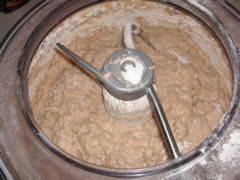
Dough is soaking in Bosch with about
six cups water and 1/2 Cup kefir and
about 12 cups of whole wheat flour.
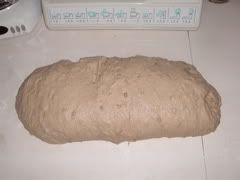
Lump of Dough - My Bosch recipe
makes about 10 lbs of bread dough

Dough is Divided into Five Equal Parts.
I make 4 loaves and one batch of
cinnamon rolls

Bread is shaped into pans. The bread dough
only fills about 1/2-2/3 of the 8" bread pan.

Bread is Ready to Bake when it has doubled
or comes to the top or just above the top of
the bread pan.

Completed Loaf. It is browned top, sides, and bottom.
Your loaf will look different depending on what size bread pan
you use, and the amount of dough you put into each pan.
Bread is also done when it reads 190 on an Instant Thermometer.
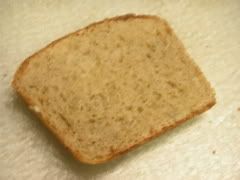
Slice of bread - The bread has even texture.
Coarse bread has been raised too long.
Urban Homemaker
Cinnamon Rolls - Illustrated with
Step by Step instructions

Using about 1 to 1 1/2 lbs leftover bread dough or
sweet roll dough, roll out a rectangular piece of Dough
approximately 12 " X 18". The dough pictured is Marilyn's Famous
whole wheat bread dough with sunflower
seeds in it, that is why it looks bumpy.
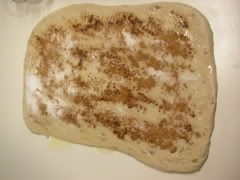
Spread the dough with 2 TB melted butter
close to but not all the way to the edge
of the rectangle. Then sprinkle with cinnamon/sugar
mixture. Use about 2 tsp cinnamon and 1/2 Cup
brown sugar or Sucanat.
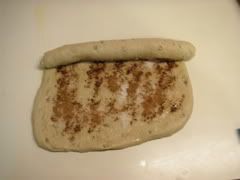
Roll up the dough along the 18" or long side for smaller
rolls with lots of layers. Or roll it along the short side for
bigger rolls and fewer layers. This example is rolled
along the 18" side.
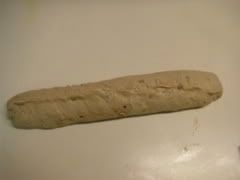
Seal the seam by pinching along the edge
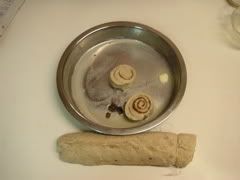
Cut 3/4 Inch Cinnamon rolls with an 18" piece
of dental floss and place in a greased baking pan.

Fill Pan - space rolls 1" apart. Allow to raise until doubled in size-
30-60 minutes.
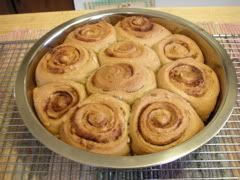
Bake the rolls until they are browned. Frost the rolls
with confectioner's frosting while warm, if desired.(The
frosting step is not pictured.
Urban Homemaker
Cracked Grain Rolls
These whole grain rolls are outstanding served for company meals and/or with hearty winter soups and stews.
2 cups hot water
2 cups Seed Mix (see below)
1/2 cup butter, softened
6 to 7 cups whole wheat flour OR 5 cups whole wheat flour and 1 to 2 cups bread flour
2tablespoons SAF yeast
1/2 cup nonfat dry milk
2 cups water
1/3 cup honey
3 eggs
1tablespoon salt
Seed Mix - Makes 2 cups
3/4 cup whole wheat, coarsly cracked
3/4 cup rye, coarsly cracked
2tablespoons flax seed
2tablespoons sesame seed
1/4 cup sunflower seeds, slightly cracked
Coarsly crack wheat and rye separately in hand mill or blender. Use high speed for about 45 to 60 seconds in blender. Be certain no whole kernels remain. Combine all "Seed Mix" ingredients and cook as directed below.
Bring hot water to a boil. Add Seed Mix, and cook 5 to 7 minutes, stirring constantly. Remove from heat, add butter, and set aside. Mix 3 cups flour, yeast, and dry milk in mixer bowl using kneading arm. (A large mixing bowl and heavy duty wooden spoon can be substituted for an electric mixer.) Mix well. Add water and honey to seed mixture. (Mixture should now be comfortably warm, approximately 120 .) Add this mixture to ingredients in mixer and mix about 1 minute. Turn off mixer, cover bowl, and let dough sponge 10 minutes. Add eggs and salt. Turn on mixer. Add remainder of flour, 1 cup at a time, just until dough begins to make a ball and clean the sides of the bowl. Knead 5 to 6 minutes. Dough should be pliable, smooth and elastic, but not sticky.
Lightly oil hands. Shape dough into balls using about 1/4 cup dough for each. Place quite close together, but not touching, on baking sheets. Let rise until double. Bake at 350 for 18 to 22 minutes. Yields 4 to 5 dozen large rolls. Put extra rolls in freezer. Recipe may be halved.
Urban Homemaker
Ezekiel's Bread
Take wheat and barley, beans and lentils, millet and spelt;
put them together in a container and make them into bread for
yourself. Ezekiel 4:9
This bread dries out quickly and therefore tastes best when
fresh. If you want the bread to last longer, use 1/3 Cup honey,
and additional flour as needed, although this modification is
not as authentic it does promote shelf life.
Preparation Tip: This
recipe calls for sprouted wheat. Use 1 cup whole wheat or spelt
kernels to make 2 cups sprouts, using Method #l at this link.
Amount: 2 Medium Loaves
Bake: 350° - 35-45 minutes
1. Dissolve yeast with honey in water in a glass measuring
cup;
let stand 5-10 minutes until bubles up:
1/4 Cup lukewarm water
1 tsp. honey
1 1/2 TB SAF
yeast
2. Blend together in blender until sprouts are well
pulverized:
2 Cups hot water (water from soaking grain can be used)
2 Cups moist wheat or spelt sprouts
3. Blend together in mixing bowl
1/4 Cup olive oil or melted unslated butter
1/3 Cup honey
1/4 tsp.
vitamin C crystals or dough enhancer
2 tsp. salt
4. Blend flours together in separate bowl; add half to the
moist ingredients:
1 1/2 cups barley flour
3/4 cup lentil flour
3/4 cup millet flour
3/4 cup soy flour, toasted
3 cups whole wheat flour or 3 1/2-3 3/4 cups spelt flour
5. Blend in proofed yeast and remaining flour.
6. Knead until smooth and elastic, adding1/2 cup or more whole
wheat or spelt flour until dough in bread kneader clears sides
of bowl or as needed to prevent sticking while hand kneading.
7. Divide dough, shape, let rise, bake, and cool as for regular
bread recipes. Brush loaves with water and sprinkle with sesame
seeds before baking, if desired.
This recipe is adapted from Sue Gregg's Yeast
Breads Book used by permission. Copyright The Urban Homemaker.
According to Sue Gregg, Ezekiel's Bread is providing complete
protein, high fiber, and vitamins and minerals for the body. Ezekiel's
bread bears a message concerning the need for spiritual renewal.
God calls for justice and righteousness among his people. It is
also a reminder that God has made complete provision for all our
needs, calling us to praise and worship him.
<To receive my free newsletter ON
MY HEART which is published twice a month with information,
product updates and reviews, delicious recipes and much more in
the spirit of Titus Two, click here.
If you haven't tried my blue ribbon winning Marilyn's
Famous Whole Wheat Bread Recipe, here is the link to the recipe.
Complimentary copies of our 64
page catalog of products for homemakers is available here.
Urban Homemaker
Fantastic Whole Wheat Rolls
For a step by step tutorial with pictures, please CLICK HERE.
These wonderful rolls will be a hit for everyday or special occasions. Halve the recipe for a small batch.
2 1/2 Cups warm water
1/2 Cup honey
1/2 Cup dry powdered milk
2 TB yeast
2 eggs
6-8 cups whole wheat flour*
2 1/2 tsp. salt
1/2 Cup oil
1/2 Cup vital gluten
2 TB dough enhancer (optional)
melted butter
Combine warm water, honey, powdered milk, and yeast in mixing bowl. Allow yeast to activate. Add eggs and 3 Cups flour. Stir until thoroughly mixed; dough will resemble cake batter. Let rest until bubbly, about 30 minutes. Add salt, oil, and remaining flour. Knead for 6-10 minutesor until gluten is developed or dough is soft and pliable. Pour out onto a lightly greased surface. Grease baking sheets. Pinch off 2-inch round portions, and roll out to an 8-inch rope. Tie rope in a single knot. Place in rows on baking sheets, cover, and let rise until double. Bake in a 350 degree oven for 20 to 25 minutes or until lightly browned. Brush with melted butter if desired, and remove to a cooling rack. Makes 2-3 dozen.
Multi-grain variation: Substitute 1 cup of 7-Grain Mix, cracked OR 1 Cup cracked wheat for one cup of the whole wheat flour.
* IF you do not have high quality fresh home milled whole wheat flour I would recommend that you use half bread flour in order to avoid heavy, dense rolls.
For more information, write to me at marilyn@urbanhomemaker.com or call me at 1-800-552-7323.
Urban Homemaker
French or Italian Bread
This recipe is very basic, simple and delicious main meal accompaniment. Double this recipe for large families!
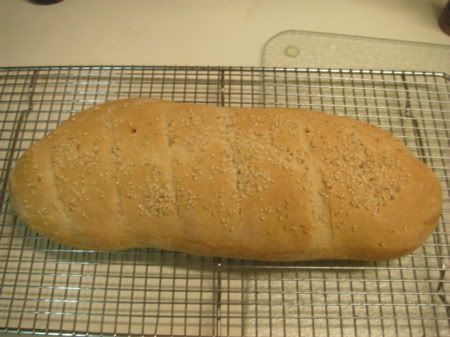
2 1/2 C. warm water
2 TB Saf Yeast
1 TB honey
2 tsp salt
2 TB oil
3 C. fresh whole wheat flour
3 Cups Bread Flour or Unbleached flour
Mix all the ingredients except the bread flour for one minute. Then add 2-3 cups of the bread flour (this is a higher protein refined flour; all-purpose flour may be substituted for the bread flour) until the mixture cleans the sides of the bowl. Knead for 6-10 minutes or until the gluten is fully developed. Allow the dough to rise 15-30 minutes in a covered bowl.
To shape the loaves: Divide the dough into two and roll each portion into a 12X15" rectangle. Roll up tightly along the long side. Pinch the edges to seal. Place on a greased cookie sheet or French Bread pans sprinkled with cornmeal. When dough doubles in size, slash the top with a serrated knife 1/4" deep every 2-3 inches. Beat one egg white with water until foamy. Use a pastry brush to coat top and sides of loaves with egg mix. Sprinkle with sesame seeds. Bake at 375�F about 25-30 Minutes or until brown.
To shape bread bowls: Use 1 to 1-1/2 cups dough per "bowl". Place dough shaped bowls onto greased cookie sheet which has been sprinkled with 2 TB yellow cornmeal or semolina flour. Bake at 375�F for 25-30 minutes or until a deep golden brown color has been achieved. Either French Bread or bread bowls can be baked on a pre-heated pizza stone for a more crispy crust. Use bread bowls as a fun way to serve chili or hearty soups & stews. You can eat the dish afterwards!
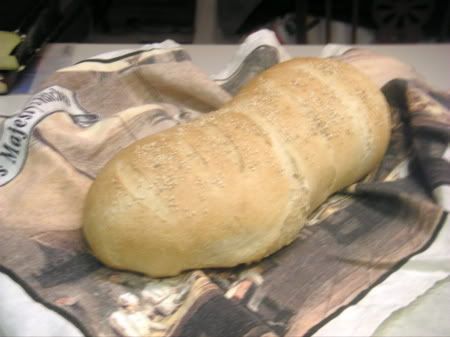 For more information email me at marilyn@urbanhomemaker.com or call 1-800-552-7323 or go to www.urbanhomemaker.com.
For more information email me at marilyn@urbanhomemaker.com or call 1-800-552-7323 or go to www.urbanhomemaker.com.
Urban Homemaker
German Stollen
German Stollen
3/4 cup raisins
1/2 cup chopped mixed candied fruits and peels
1/4 cup currants
1/4 cup rum (optional)
4 to 4 1/2 cups all-purpose flour
2 TB SAF
1 cup milk
1/2 cup butter or margarine
1/4 cup sugar
2 eggs
1/2 teaspoon almond extract
2 tablespoons grated orange peel
1 tablespoon grated lemon peel
1/2 cup chopped blanched almonds
Confectioners' Icing
Soak raisins, mixed fruits, and currants in 1/4 C. water
(or rum). In large mixer bowl, combine 1 1/2 cups of the flour
and the yeast. Heat milk, butter, sugar, and 1 teaspoon salt
til warm (115-120°F), stirring constantly to melt butter.
Add to dry mixture; add eggs, almond extract, and peels.
Mix thoroughly by hand or the dough hook of a heavy duty mixer.
Stir in fruit-rum mixture, nuts, and enough remaining flour to
make soft dough. Knead on floured surface til smooth (8-10 minutes),
or in a mixer until the gluten is developed. Shape into ball.
Place in greased bowl; turn once. Cover; let rise til double
(about 1 1/4 hours). Punch down; divide in half.
Cover; let rest 10 minutes. Roll each half to 10X7-inch oval.
Fold long side of oval over to within 1/2 inch of opposite side;
seal edge. Place on greased baking sheets. Cover, let rise until
double (about 45 minutes).( Breads made with lots of nuts and
fruits will not rise as high as regular breads.) Bake at 375°F
til done, about 15 to 20 minutes. While warm, glaze with Confectioners'
Icing. Garnish with candied fruits, if desired. Makes 2 coffee
cakes.
Confectioners' Sugar Icing: In small bowl, combine
2 cups confectioners' sugar, 1 teaspoon vanilla extract and 2
to 3 tablespoons milk. Beat until smooth.
Urban Homemaker
HOT CROSS BUNS
Remember the children's nursery rhyme that goes as follows?
Hot cross buns! Hot cross buns!
One a penny two a penny - Hot cross buns
If you have no daughters, give them to your sons
One a penny two a penny - Hot cross buns
Hot cross buns were sold in the street to the cry of "Hot cross buns!" around the period in English history dating back to the seventeenth and eighteenth century.
A hot cross bun is a type of sweet spiced bun made with currants and leavened with yeast. It has a cross on the top which might be made in a variety of ways. Using confectioner's frosting, is the most common way.
According to one source, hot cross buns are traditionally eaten on Good Friday, with the cross standing as a symbol of Christ and the resurrection. Have fun with the children and enjoy the process of being together in the kitchen. Here's my recipe for the buns:
Hot Cross Buns
2/3 cup dried currants
3-1/2 to 4 cups whole wheat flour (or half bread flour and half whole wheat
2 TB yeast
1/2 to 1 tsp cinnamon
3/4 cup milk
1/2 cup cooking oil
1/3 cup sugar or honey
1 tsp salt
3 eggs
1 slightly beaten egg white
Frosting (recipe follows)
Cover currants with very hot water. Let stand about 10 minutes or up to one hour at room temperature. Drain well. In a large mixing bowl combine 2 cups flour, yeast, and cinnamon. Heat milk, oil, sugar or honey, and salt until warm (115 to 120�). Add to the dry mixture. Allow to sponge for about 15 minutes if time allows. Add eggs, one at a time. By hand or mixer, stir in currants and enough remaining flour to make a soft dough. Knead until the gluten is developed by mixer or on a lightly floured surface until smooth and elastic, about 6-10 minutes.
Shape into ball. Place in greased bowl. Turn once to grease top. Cover with plastic wrap and let rise in warm place until doubled in bulk, about 1-1/2 hours. Punch down. Cover and let rest 10 minutes.
Divide into 18 pieces. Form smooth balls. Place on greased baking sheet 1-1/2 inches apart. Cover; let rise until double, 30 to 45 minutes. Cut shallow cross in each. Brush tops with egg white. Bake in preheated 375� oven 12 -15 minutes. Remove from baking sheet. Use confectioner's Frosting to make a "cross" on the bun.
Confectioner's Frosting:
2 TB milk
1 cup sifted powdered sugar
1/2 tsp. vanilla
Combine these ingredients together and add milk or water as needed to get a good pouring consistency for the frosting. Place the frosting in a small zip-lock sandwich baggie, clip the corner and use the baggie to squeeze the frosting over the cooled buns in a cross shape. Small children will enjoy this process even if it gets a little messy!
More Easter Themed Activities:
1. To learn to dye Easter eggs with natural colors, CLICK HERE.
2. Another fun Resurrection project is Resurrection Cookies.
A Beginner's Guide to Baking Bread ebook by Marilyn Moll offers step-by-step instructions for getting started with baking yeast breads.
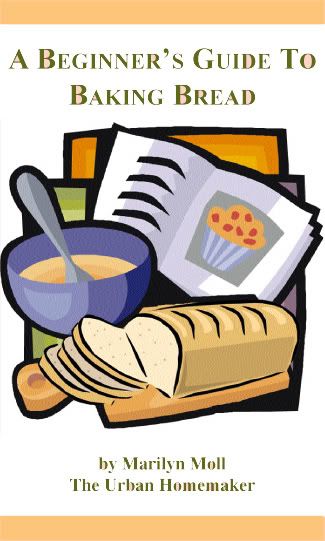
Click Here to purchase this instantly downloadable ebook for $9.95.
Learn how to:
* How to Select Ingredients
* Selecting a Grain Mill
* Selecting A Mixer
* Step-by-Step Mixing Instructions
* How to Develop the Gluten
* Tips for the Best Bread
* Lots of Bread and Roll Recipes
* Troubleshooting Guide
* The Two-Stage Process
Item #6059 $9.95
Click Here to purchase this ebook for $9.95.
Urban Homemaker
Multi - Grain Bread
This hearty bread
is delicious! Don't be afraid to try it. If you don't have all
the seeds and grains just omit them and use additional whole wheat
flour. This recipe is for an automatic bread machine and lists
the order in which to add the ingredients.
If you want to
make this recipe by hand kneading, just double the amounts listed.
For the large mixer method, multiply the amounts by four and mix
as you would for Marilyn's
Famous Whole Wheat Bread Recipe
Zojirushi Method
1-1/4 cups warm water
1/3 cup cracked 7-grain blend
2 TB sunflower seeds
1 TB millet
1 TB flax seeds
1 TB sesame seeds
1 TB amaranth grain
1/4 cup vital gluten
2 TB oil
2 TB honey
1-1/2 tsp. salt
2 tsp. dough enhancer
2 tsp. yeast
2-1/2 to 3 cups whole wheat flour
To download my free ecookbook Fast
and Health Recipe for Busy Homeschooling Moms, click on this
link.
To receive my free newsletter ON
MY HEART which is published twice a month with information,
product updates and reviews, delicious recipes and much more in
the spirit of Titus Two, click here.
If you haven't tried my blue ribbon winning Marilyn's
Famous Whole Wheat Bread Recipe, here is the link to the recipe.
Complimentary copies of our 64
page catalog of products for homemakers is available here.
Urban Homemaker
Overcoming Gluten Intolerance
by Marilyn Moll
Overcoming Gluten Intolerance -
The Two-Stage Process - Does it make a difference and why?
The two-stage process is a term coined by Sue Gregg, author of Sue Gregg Cookbooks, for a method of preparing yeast breads in which the grain or flour is soaked, sprouted, or fermented, for a period of time, prior to kneading the dough, in order to maximize the nutritional value of whole grain bread.
Soaking, sprouting, or fermenting the flour or grain are methods used traditionally by our ancestors for preparing grains, porridges, or breads. These slower, more gentle methods contrast sharply with modern factory and commercial baking techniques. Only recently has research documented the chemical changes that occur using these slower methods and the corresponding health benefits.
According to Sally Fallon and Dr. Mary Enig, in their book Nourishing Traditions, enzyme inhibitors, tannins, complex sugars, difficult to digest proteins, “anti-nutrients” (substances which put a strain on our digestive system and pancreas), and other factors in whole grains contribute to a variety of digestive disorders. It has been hypothesized that improperly prepared whole grains, consumed for a long period of time, may contribute to increasing incidences of gluten intolerance, grain allergies, celiac disease, chronic indigestion, mineral deficiencies, and bone loss.
The slow process of soaking flour or whole grains in an acidic environment neutralizes phytic acid, which is contained in the bran, and which blocks absorption of minerals, and significantly boosts the availability of vitamin and mineral content to the body. The authors point out that “Tannins, complex sugars, gluten and other difficult-to-digest substances are partially broken down into simpler components that are more readily available for absorption.” during the soaking, sprouting, or fermenting process.
In addition, Fallon and Enig write in Nourishing Traditions:
“Our ancestors, and virtually all pre-industrialized peoples, soaked or fermented their grains before making them into porridge, breads, cakes and casseroles. A quick review of grain recipes from around the world will prove our point: In India, rice and lentils are fermented for at least two days before they are prepared as idli and dosas; in Africa the natives soak coarsely ground corn overnight before adding it to soups and stews and they ferment corn or millet for several days to produce a sour porridge called ogi; a similar dish made from oats was traditional among the Welsh; in some Oriental and Latin American countries rice receives a long fermentation before it is prepared; Ethiopians make their distinctive injera bread by fermenting a grain called teff for several days; Mexican corn cakes, called pozol, are fermented for several days and for as long as two weeks in banana leaves; before the introduction of commercial brewers yeast, Europeans made slow-rise breads from fermented starters; in America the pioneers were famous for their sourdough breads, pancakes and biscuits; and throughout Europe grains were soaked overnight, and for as long as several days, in water or soured milk before they were cooked and served as porridge or gruel.” (Many of our senior citizens may remember that in earlier times the instructions on the oatmeal box called for an overnight soaking.)” (pg. 452)
My bread recipes do not reflect the two-stage process, because I encourage beginning bakers to master the basics of yeast bread making before undertaking this soaking, sprouting, or fermenting method.
Although I had started making fermented bread with a wild-caught sour dough starter several years ago (one of the methods mentioned in Nourishing Traditions, I found the very slow rising time resulted in very sour bread and the very long raising time was often not compatible with my busy schedule. Sue Gregg introduced me to the Two-Stage Process which I find works well with my schedule; in fact, I would consider this method somewhat of a convenience.
Bread that has been made using the two-stage process is moister for longer periods of time, and stales very slowly.
TWO-STAGE PROCESS FOR YEAST BREADS
Adapting Marilyn's Famous Whole Wheat Bread -Recipe to maximize nutritional value
1. Soak the whole grain flour in liquid. Using 1 tbsp. of an “acid” medium such as kefir, yogurt, buttermilk or whey for each cup of water called for in Marilyn's Bread Recipe. For example, if a recipe calls for 6 cups water, use 6 tbsp. kefir, yogurt or buttermilk along with the water. You can substitute lemon juice or vinegar instead if you suspect dairy intolerance.
Add the honey and oil called for in the recipe along with enough flour to make a thick batter. Mix the liquid and flour ingredients only until moistened and then begin the “soaking” time. For the hand method, use about 5- 6 cups whole grain flour. Use 11-12 cups flour for the Large Mixer method.
Twelve to twenty-four hours or more soaking time will yield the best results. The longer you soak the flour the more sour dough-like taste it will have. However, be flexible, soak the flour as long as you have time for so that this process fits into your routine smoothly; any soaking time improves texture, nutrition, and flavor. Just mix the liquid and water long enough to moisten the flour before the soaking time begins. This is a little bit like "sponging" however no yeast is used. Cover the bowl with plastic wrap or a damp cloth to prevent it from drying out.
2. After the liquid, honey, oil, and flour has soaked, blend the following in a liquid measuring cup and allow to proof for 10 minutes:
1/4 cup-1/2 cup warm water
SAF yeast called for in the recipe (conventional yeasts may be substituted)
1 tsp. honey or sugar
3. Work the yeast mixture into the dough along with enough flour until the dough begins to clean the sides of the bowl.
4. Be sure to add the salt, and enough unbleached bread flour or additional whole grain flour as needed so that the dough is easily handled and knead the bread until the gluten is developed. For whole wheat bread it takes about 8 minutes kneading time in a Bosch mixer, or 10-12 minutes of vigorous hand kneading (about 600-800 strokes).
5. Be sure to add as little flour as needed to keep the dough moist but not sticky or from becoming too stiff (a sign that too much flour has been added). Knead the bread until it becomes smooth and elastic, and resistant to the kneading action. Check to see if the gluten is fully developed.
6. Complete the recipe according to Marilyn's Famous Whole Wheat Bread recipe instructions for the particular version you are making. Allow the dough to rise once in a greased bowl, and once in the bread pans. Be prepared that the rising time will take longer because the dough is lower in temperature from sitting at room temperature. (Ideal rising temperature is 85 degrees.)
7. Allow the bread to double in pans; bake at 350°F for 30-40 minutes or until the loaf is well browned on the top, sides, and bottom.
This two-stage procedure can be used with any yeast bread recipe.
Conclusion
When you have learned to use a variety of whole grains in your diet, and your family has accepted this change, then you might want to consider moving on to the new step of adapting your recipes to the two-stage process.
Sue Gregg writes, “I suggest that occasional consumption of whole grains that are not processed by one of the three two-stage methods (soaking, fermenting, sprouting) is not likely detrimental to health and may contribute a plus, while those that are properly processed as the main dietary choice will be greatly beneficial to health."
Pg. 14 - An Introduction To Whole Grain Baking
Learning to prepare breads and grain products with slower methods may seem daunting or a bit intimidating or even overwhelming to a beginning baker just becoming acquainted with whole grains. If so, put this two-stage process information on a shelf, and come back to it when you are ready.
Urban Homemaker
PECAN CINNAMON STICKY BUNS
MARILYN'S FAMOUS PECAN STICKY CINNAMON
BUNS
If you would like to have hot-out-of-the-oven rolls without
getting up at 4:00 a.m., prepare the rolls a day ahead. Place
the shaped rolls on the maple glaze and raise them overnight in
the refrigerator (instead of a warm place), keeping them carefully
covered with plastic wrap. In the morning, the dough should have
doubled and be ready to bake. Voila! Fresh bread in minutes
and you didn't even get up at 4:00 a.m. to do it! This recipe
is extra delicious and healthy as it contains maple syrup and honey for
sweetening instead of sugar . A fabulous gift to a new
mom or new neighbors, or just for being friends.
2 cups warm water (120°F)
2TB SAF Yeast
1/2 cup dry milk powder
1/2 cup oil or butter
1/3 cup honey
3 large eggs
1 TB Salt
6-8 cups whole wheat flour
1/4 cup Vital Gluten
Caramel Topping:
1/2 cup butter
1-1/2 cup maple syrup
1-1/2 cup chopped or whole pecans
Cinnamon Roll Mixture:
1 cup SUCANAT (unrefined sugar found in health food stores)
or brown sugar
1 TB + 1 tsp. cinnamon
1/4 cup butter, melted
Combine yeast, dry milk powder, vital gluten, and
flour in a large mixer bowl. Add water, oil, and honey. Mix
well for 1-2 minutes. Turn off mixer, cover the bowl and let
dough sponge for 10-15 minutes. Add eggs and salt. Turn on the
mixer; add additional flour, one cup at a time, until the dough
begins to clean the sides of the bowl. Knead for only 5 minutes
and keep the dough very soft and manageable. (Stiff dough
will produce heavy, dry rolls.) If the dough becomes stiff while
kneading, drizzle additional water as you knead. To prepare sticky
buns, melt butter and syrup and add the pecans. Divide this mixture
evenly into the bottom of two - 9x13 baking pans. Divide the
bread dough into two equal portions. Roll into a 20x28 inch rectangle.
Spread 2 TB of melted butter over the rectangle of dough. Sprinkle
with half the SUCANAT/cinnamon mixture. Roll up into a "jelly
roll", seal the seam, and cut into 1-1 1/2 inch thick pieces
with dental floss. This will yield 12-15 rolls. Place the rolls
into the prepared pans. Repeat this process with the remaining
dough. Let the rolls raise in a warm area until doubled (approximately
30-60 minutes). Bake at 350 degrees for 30-35 minutes or till
well-browned. Remove from the oven and let stand in the pan for
5 minutes. Turn out of the pan to cool onto a rack placed over
a jelly roll pan (to catch the drippings and simplify cleanup).
ENJOY!
To download my free ecookbook Fast
and Health Recipe for Busy Homeschooling Moms, click on this
link.
To receive my free newsletter ON
MY HEART which is published twice a month with information,
product updates and reviews, delicious recipes and much more in
the spirit of Titus Two, click here.
If you haven't tried my blue ribbon winning Marilyn's
Famous Whole Wheat Bread Recipe, here is the link to the recipe.
Complimentary copies of our 64
page catalog of products for homemakers is available here.
Urban Homemaker
Poppy Seed Roll
Poppy Seed Roll
Makes 2 rolls
5 to 5 1/2 cups all-purpose flour
1/2 cup sugar
2 TB SAF yeast
1 cup milk
2 tablespoons grated lemon peel
1/2 cup water
1 cup (2 sticks) butter
1 teaspoon salt
1 egg, lightly beaten
Poppy Seed or Honey Nut filling (recipes follow)
Additional ground nuts or poppy seed, optional
Confectioners' Sugar Frosting, optional (recipe follows)
In large bowl, mix 2 cups flour, sugar, undissolved yeast,
lemon peel and salt. Heat milk, butter and water until hot to
touch (125 to 130°F). Butter does not need to melt. Gradually
add to dry ingredients. Mix thoroughly with a wooden spoon or
using a dough hooks, and then stir in enough additional flour
to make stiff dough. Knead by mixer or by hand on lightly floured
surface until smooth and elastic, about 8 to 10 minutes. Place
in greased bowl, turning to grease top. Cover; let rise until
doubled in size, about 75 minutes.
Punch dough down; divide in half. Roll each half to 10X15-inch
rectangle. Top each with 1/2 poppy or nut filling, spreading
to within 1/2-inch of edges. Roll up from long end as for jelly
roll. Pinch seam and ends to seal. Place loaves on greased baking
sheets. If desired, curve ends to make a horseshoe. Cover; let
rise in warm, draft-free place until risen slightly, 30 to 45
minutes.
Brush loaves with beaten egg. Bake at 350°F for 35 minutes
or until done. Remove from baking sheets. Cool on wire racks.
If desired, frost with confectioners' sugar frosting and garnish
with additional ground nuts or poppy seed.
Poppy Seed Filling: Combine 3/4 cup poppy seed, 1/4
cup milk, 1 cup sugar, and 1 tablespoon grated lemon peel in saucepan.
Cover over medium heat, stirring constantly, until mixture boils
(about 5 minutes); cool. Filling will thicken on standing. Increase
baking time to 45 minutes; if necessary, cover with foil to prevent
excess browning.
Honey Nut Filling: In small bowl, combine 2 1/2 cups
ground walnuts, 1/2 cup honey, 1 teaspoon vanilla extract and
1 teaspoon ground cinnamon. Blend well.
Confectioners' Sugar Icing: In small bowl, combine
2 cups confectioners' sugar, 1 teaspoon vanilla extract and 2
to 3 tablespoons milk. Beat until smooth.
Urban Homemaker
Sourdough Starter and Bread Recipes
Sourdough starter is easy to make, and you can make new
starter anytime you want to. Acquiring some "famous"
starter that has been in the family or among friends for generations
or that came out of San Francisco isn't a necessity.
I have found that sour dough is really quite forgiving,
and although recipes give basic guidelines for using sour dough
starter, you can be quite flexible, and still have great results.
Use your starter in any favorite bread recipe, but be patient,
it takes longer to rise.
I have particularly enjoyed using my sourdough starter for
pancakes, cinnamon rolls, dinner rolls, and occasionally sandwich
breads.
I even took my starter with me when we went camping last
summer and had delicious bread baked in the dutch oven using my
basic Marilyn's Famous Whole
Wheat Bread Recipe using the hand method. I made the bread
in the morning and baked it at dinner time. I used about 1 tsp.
of yeast instead of 2 TB.
BASIC SOUR DOUGH STARTER:
Blend in a quart-size non-metal bowl or crock (sourdough reacts
with metal) and let stand 5-10 minutes till bubbly:
1. 1/2 cup lukewarm water or potato water (95° -105°F)
1 TB SAF
dry yeast
1/2 cup whole wheat pastry flour or unbleached white flour
2. Blend in additional:
1/2 cup lukewarm water or potato water (95-105°)
1/2 cup whole wheat pastry flour or unbleached white flour
3. Cover loosely with plastic wrap or cheesecloth; let stand
in a corner 2-6 days. Stir down with non-metal spoon as it bubbles
up. A day or two longer may be needed if the weather is cool.
Top of the refrigerator is usually a warm place.
4. Store the starter in a glass or crock container in the refrigerator,
at least 12 hours before using.
5. To use Refrigerated starter: Remove starter from
refrigerator, stir down any dark liquid, bring portion to be used
to room temperature (always reserve an unused portion for step
#6).
6. Replenish the unused starter with equal parts of warm water
and flour about 1/2-1 cup of each. Cover loosely and refrigerate.
After you have replenished the starter give it at least 24 hours
before using it again.
Tips:
Dark liquid rises to the top can be stirred back in, it is not
a sign of failed or spoiled starter. If mold appears, remove it.
Discard starter only if any pink color is present.
For Best Results:
Use your starter twice weekly, or at minimum every 2 weeks to
prevent its becoming too sour. If no used freuently one of the
following options can be followed:
1. Freeze it in 1 cup portions.
2. Throw half away and replenish the remainder (see step #6) .
Repeat with unsued starter periodically.
3. Discard it and make new starter, if needed.
4. I have found the more often I use the starter the better, but
I have not used the starter for months at a time, and it always
comes back to life, as long as refrigerated.
To Use Sourdough Starter in Recipes:
Sourdough starter can be used in English muffins, yeast
breads, and rolls using these general guidelines.
1. Use 1/2-1 cup starter. Reduce liquid and flour in
the recipe by same amount that is in the starter.
2. Replenish leftover sourdough starter and return to refrigerator
(step #6, p.36).
3. Several hours or the night before make a sponge by blending
the starter with the main liquid used in the recipe (lukewarm
water, not hot), and part, or all of the flour to keep the sponge
at a batter caonsistency. Let stand several hours or overnight,
4. In the morning blend in remaining ingredients. Active dry
yeast can be omitted for a natural leaven bread, or reduce the
amount of yeast used in the recipe by 1/3. For example, if the
recipe calls for 3 TB yeast, I use 1 TB.
Sourdough starter may be used in any pancake, waffle, biscuit,
or muffin recipe.
The above information is adapted from Sue Gregg's Yeast
Breads Book.
If you have any additional questions about baking with sourdough,
just contact me at marilyn@urbanhomemaker.com or call us at 1-800-552-7323.
Free 64 page catalogs of all of our products and much more are
available at http://www.urbanhomemaker.com/catalog.
Urban Homemaker
Sprouted Grain - For use with 100% Sprouted Wheat Bread and Ezekiel's Bread
SPROUTED GRAIN METHOD:
Here is the method for making Sprouted Grain for 100% Sprouted
Wheat Bread and other recipes. Large amounts of grain can be sprouted
ahead, dried, and stored until needed.
SPROUTED GRAIN
Sprouted (or soaked) grain is used in four recipes
in Yeast
Breads: 100%
Sprouted Wheat Bread, Sprouted Rye-Wheat Bread, Sprouted Oat-Wheat
Bread, and Ezekiel's
Bread. Sprouted grain can be used in other recipes as well.
Use one of these Methods To Sprout the Grain:
#1 sprouted grain gives the bread a distinct sweet
sprouted grain flavor.
#2 Soaked Grain gives the bread a slightly "sourdough"
flavor.
Preparation Tips: Part of the grain used in
the sprouted bread recipes is used moist and part of it is used
dried and milled into flour. Any amount of sprouted or soaked
grain to be used dried and milled into flour can be prepared in
advance and stored after drying.
For sprouted or soaked grain that is going to be used moist,
make no more than will be needed within a day or two (1 cup dry
grain= about 2 cups sprouted)
METHOD #1 SPROUTED
GRAIN (For a medium Loaf Bread)
To Sprout grain use a Sproutmaster
1. Soak overnight:
4 cups whole wheat kernels
2 quarts water
2. Drain, Saving soaking water to use as hot liquid in bread
recipe (refrigerate until needed).
3. Sprout Grain
for 1 day only for very short sprouts - 1/16" to 1/8"
long; keep grain well drained, but damp, watering it twice.
4. Store 2 cups sprouted grain in refrigerator in tightly
covered container until needed (not over a day or two).
5. Thoroughly
Dry Out remaining grain. When thoroughly dried, mill
into flour (any dried grain not to be used immediately
may be stored in tightly covered container in cool place; do not
mill into flour until ready to use). Grain may be dried in a dehydrator
at low temperatures to preserve nutrients or in a warmed oven.
6. Use moist refrigerated grain and milled flour as directed
in specific recipes.
METHOD #2 SOAKED GRAIN (For 1 Medium loaf
of bread)
1. Using same amount of grain and water as
step #1 above; cover container with loose fitting lid; soak for
3 days at room temperature.
2. Proceed with steps #2, 4-6 of Method #1 above.
The above information comes from p. 64 Yeast
Breads by Sue Gregg of Sue
Gregg Cookbooks. Used by permission.
To download my free ecookbook Fast
and Health Recipe for Busy Homeschooling Moms, click on this
link.
To receive my free newsletter ON
MY HEART which is published twice a month with information,
product updates and reviews, delicious recipes and much more in
the spirit of Titus Two, click here.
If you haven't tried my blue ribbon winning Marilyn's
Famous Whole Wheat Bread Recipe, here is the link to the recipe.
Complimentary copies of our 64
page catalog of products for homemakers is available here.
Urban Homemaker
WHOLE WHEAT BREAD DOUGH VARIATIONS
WHOLE WHEAT BREAD VARIATIONS
Any basic bread dough can be made into many tasty variations
limited only by your imagination. Why not try Marilyn's
Whole Wheat Bread recipe for a basic bread dough and fashion
it into pizza,
cinnamon rolls, bread sticks, onion cheese bread, etc?
WHOLE WHEAT PIZZA
Use approximately one loaf of bread dough(1 1/2 pounds dough)
for each pizza
crust. If you are not baking the crust on a Pizza
Stone, you will be much more successful if you pre-bake the
crust for 6-8 minutes, and then cover it with toppings of your
choice. Be sure to have all your toppings ready, or wrap and freeze
pizza
crusts for future meals.
CINNAMON PULL-APARTS
Pinch dough off into walnut size balls. Dip in melted
butter and then roll in cinnamon sugar mixture (1T cinnamon to
1/2 C. sugar or sucanat). Place balls in layers, at least two
layers or one-half to two thirds full), in a regular loaf pan
or bunt pan. Let rise until doubled in bulk, bake at 350°
for 20-30 minutes.
CARAMEL NUT PULL APARTS
Make caramel sauce by melting 1/4 cup butter, 1/2 Cup
brown sugar, and 1/2 C. maple syrup in a saucepan, add 1/2 cup
chopped walnuts or pecans if desired. Pour this mixture into the
bottom of a bundt pan or 9X13" baking pan. Place walnuts
sized pieces of dough in layers in the pan. Let rise until doubled,
bake at 350° for 20-30 minutes.
MOCK RYE BREAD
For each loaf of bread, cut in 1 T caraway seed and 1 tsp. anise
seed.
BREAD STICKS
Roll 1/2 Cup portions of dough into finger-thin ropes and cut
to the desired length. Brush with melted butter. Sprinkle with
a desired topping: Parmesan cheese, garlic salt, or powder, Italian
Seasonings, sesame seeds, etc. Place the "sticks" onto
a lightly greased baking sheet, about 2 inches apart. Let rise
10-15 minutes. Bake at 375 degrees for 18-18 minutes.

ONION CHEESE BREAD
For each loaf, knead in 1/4 cup chopped onion (or reconstituted
minced onion) and 1/2 C. grated, sharp, cheddar cheese. Proceed
with regular rising and baking.
CINNAMON-RAISIN BREAD
Knead in 1/2 cup raisins and 1/2 cup chopped walnuts or pecans
plus 1 1/2 tsp. cinnamon.
GARLIC-HERB PARMESAN BREAD
For each loaf, add 1/3 cup parmesan cheese and 1 tsp. garlic powder
or more to taste, and 1 tsp. of herb of choice (optional).
JALAPENO-RANCH SHARP CHEESE
Add 1/2 Cup grated sharp cheese, 2 TB ranch salad dressing mix,
and 2 chopped fresh jalapeno peppers.
ONION HAMBURGER BUNS:
Add 1 TB onion powder. Roll to slightly less than 1/2 inch thickness
and cut with a can about 4 inches diameter. (Cut out both ends
for air to escape) If desired, moisten the top of buns and sprinkle
with onion flakes before rising. Bake 18-20 minutes at 350°.
ONION-DILL
For each loaf, add 2 slightly heaping tablespoons of dried onion
flakes (or 1 TB onion powder) and 2 tsp. dill weed.
DRIED TOMATO AND ROSEMARY BREAD
For each loaf, add 3 TB snipped dried tomatoes, 1 tsp. crushed
rosemary, and 1/4 tsp. paprika.
CINNAMON ROLLS WITH APPLE FILLING
In a medium mixing bowl, combine 2 C. finely chopped or grated
apple, 1/2 C. raisins or dates, 2 T honey or brown sugar, 2 tsp.
cinnamon or apple pie spice, dash of salt. For each loaf of bread,
roll out the dough into a 12 X 18 rectangle, spread the apple
mixture over the dough, roll up tightly, seal the roll, and cut
rolls into 3/4-1 inch slices with dental floss.
To download my free ecookbook Fast
and Health Recipe for Busy Homeschooling Moms, click on this
link.
To receive my free newsletter ON
MY HEART which is published twice a month with information,
product updates and reviews, delicious recipes and much more in
the spirit of Titus Two, click here.
If you haven't tried my blue ribbon winning Marilyn's
Famous Whole Wheat Bread Recipe, here is the link to the recipe.
Complimentary copies of our 64
page catalog of products for homemakers is available here.
Urban Homemaker















 For more information email me at marilyn@urbanhomemaker.com or call 1-800-552-7323 or go to
For more information email me at marilyn@urbanhomemaker.com or call 1-800-552-7323 or go to 
